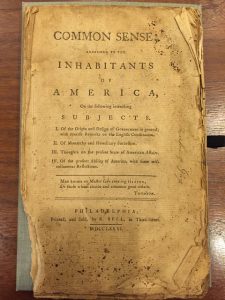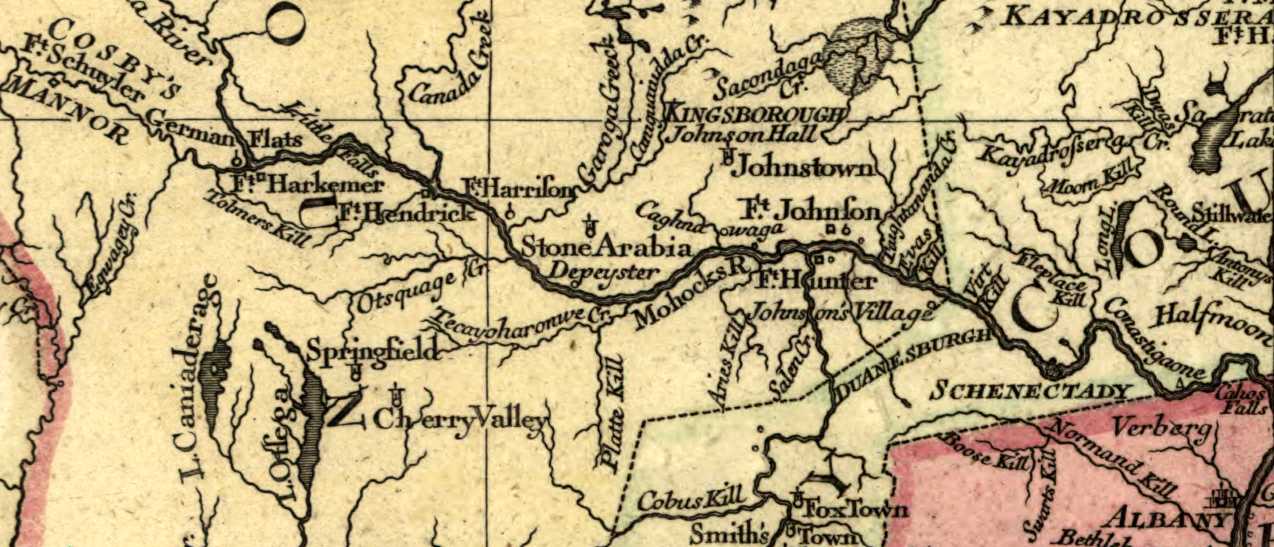It would be hard to find a more strident, vocal supporter of popular government during America’s founding period than Thomas Paine. The proposals put forth in his January 1776 pamphlet Common Sense for an “unmixed” and unchecked democratic scheme for America, designed to replace the British arrangement of balanced and mixed powers of King, Lords and Commons, were radical.[1] Remarkably, the pamphlet appeared just over a year after Paine had immigrated to America from England. But while his ideas helped push the colonies toward separating from British rule, they rattled at least one leading voice for independence in the Second Continental Congress. John Adams asserted that Paine’s ideas were too “democratical.”[2] A decade later Paine agreed, at least on several important points.
Believing that the true source of legitimate power was to be found only in the sovereignty of the people and not in any governmental institutions or claims to higher authority, Paine set out in Common Sense—following forceful arguments urging Americans to separate themselves from Great Britain—to outline what kind of government the colonies should create: a new, more egalitarian, democratic scheme of representative government. “Let the assemblies be annual, with a president only. The representation more equal, their business wholly domestic, and subject to the authority of a Continental Congress.”[3] Although many welcomed Paine’s vigorous call for independence, his simple formula for “a government of our own” in Common Sensemust have elicited a sardonic smile or two at the time. It still does.
At the heart of Paine’s proposals was his advocacy of a unicameral legislative body with no independent executive, no mention of a judiciary and no internal balanced powers or checks anywhere to be found. Instead, he envisioned separate roles for the colonial assemblies and the national Congress to play, divided along the lines of domestic and international duties. And he hinted at a fundamental principle of a federal structure: any such a division of delegated powers between the states and national government should tilt in the direction of the latter.

But Common Sense found no room for royalty, aristocracy, or clerical absolutism. These were relics of the Old World, Paine advised. There was no place in Paine’s recommendations for America for the venerated “balanced” powers in the British constitution that French thinker Montesquieu so admired in the British model.[4] For there was nothing left to balance. The only institution that Paine found useful in the British system of government was the Commons. But it was corrupted by the allegiance-owing king’s ministers. So, Paine did away with the foundations of British authority and representation and grounded both instead in the people.
One who did not find Paine’s ideas so attractive was Adams, a kindred rebellious spirit and powerful voice for independence in the Congress. Alarmed by Paine’s radical recommendations for government in Common Sense (though supportive of the pamphlet’s call for independence and envious of its popular appeal), he rushed to counter Paine’s proposals for forming a government by publishing a pamphlet of his own later that spring: Thoughts on Government: Applicable to the Present State of the American Colonies.[5] Holding that the only valuable thing about the British constitution was its republican features (a republic is an “empire of laws, and not of men”) Adams set out in his pamphlet to build a better republican model than Paine’s democratic prescriptions offered.
Adams made no bones about his skepticism of Paine’s single-chamber, all-powerful legislature, wondering whether all powers of government, legislative, executive, and judicial, should be contained in a single legislative body. He answered no, because such an assembly would be “liable to all the vices, follies and frailties of an individual.”[6] Paine did not possess this insight, at the time.
The Second Continental Congress meeting in Philadelphia that spring and summer had two competing, widely read pamphlets informing delegates of what sort of republican government ought to replace British rule, should independence be declared. Many colonies were already in the process of building their own new governments, drawing on ideas from these and other sources.
After the Declaration of Independence was promulgated in July, Congress moved to create America’s first national constitution by proposing the Articles of Confederation. Paine’s recommendations for a single-house legislative body, devoid of separation of powers and checks and balances, contrary to Adams’ proposals, prevailed and was formally put into place at the successful conclusion of America’s War for Independence. Adams paid little attention to the structure of the national government when writing down his proposals in Thoughts on Government for new colonial constitutions.[7]
Differing from Paine’s thinking, the new states’ powers remained superior over those meager few delegated by the Articles to the Congress. But many of Adams’ recommendations, though he supported the creation and ratification of the Articles, informed several of the new state governments being created at the time and eventually were incorporated in the proposals for a new Constitution in 1787.
Pennsylvania’s first constitution had more similarities to Paine’s democratic proposals found in Common Sense. Though he worked for a while as a clerk to the Pennsylvania Assembly, he was never a delegate, just as he never was to the Continental Congress. But his influence was certainly apparent in the structure of both the Articles and Pennsylvania models from the start. Notably however, both constitutions were short lived. Both were flawed, but for different reasons: A lack of power for national government and unbridled legislative powers in a single-chamber assembly in Pennsylvania where the powers of a partisan majority could be wielded unchecked. The Articles were replaced by the ratification of the Constitution, the Pennsylvania constitution, soon after.
At least one Paine scholar has questioned the notion that Pennsylvania’s constitution of 1776 was the most democratic of all the states. Pointing out that the constitution was never approved by a vote of the people, that representation was not based on “per head” but on counties (giving the western “back-country” counties an advantage over the Assembly from the beginning), and that it disenfranchised most of the eligible electorate in the state, J.C.D. Clark argued that the idea was a myth. He also pointed out that Paine had no objections to the constitution’s arrangements.[8]
In his last published pamphlet prior to heading off to Europe on the eve of the Constitutional Convention (both Paine and Adams were in Europe during the Convention), Paine confronted the stresses and cracks in the functioning of the Pennsylvania model: the problem of an overbearing majority. His Dissertations on Government: The Affairs of the Bank: And Paper Money, 1786,[9] came about because of actions taken by “back-country” Pennsylvania farmers and the Constitutionalist Party they controlled in the Pennsylvania Assembly beginning in 1785.
The most important problem that Paine addressed in his pamphlet as well as in letters and articles in the local papers at the time, was that the state assembly revoked the Pennsylvania charter of Robert Morris’s Bank of North America, chiefly over its preference for paper money.[10] Rural debtors feared that the value of paper money, which the state had attempted to regulate to help, among other things, keep the farmers afloat, would not be accepted on par with money, based on specie, issued by the national bank. They believed the bank unfairly favored the urban, mercantilist class. The conflict began about the same time as Shays’s Rebellion, a similar battle, though one much more threatening and violent, between debtors and creditors, that broke out in Massachusetts.
The Pennsylvania dispute tested Paine’s majoritarian principles, for he also favored the national bank.Originally aligned with the Constitutionalist Party, he broke with it over the issue. Paine was an early nationalist: he believed that a national bank was necessary to tie the colonies (and then states following Independence) together, in order to fund and win the war, and then to establish an independent nation. A national debt, he declared in Common Sense, is a national bond. Conflicts over national and state monetary policies such as those arising in Pennsylvania and Massachusetts amounted to existential threats to the new nation.
He also earlier had worked for a time for Robert Morris, a point not lost on the farmers who accused Paine, after publishing his articles and Dissertations on Government, of abandoning the common man by defending the bank. They accused him of being a hired pen.[11]
But Paine’s pamphlet revealed that he was beginning to explore limits to the principles of majority rule. His solution to limiting an overbearing majority was found in the idea of fundamental law. An enabling charter, such as that of the national bank, was the kind of law, like a constitution, that could not, he argued, be overridden by routine legislation.
For admitting a question of law to arise, whether the charter, which that act attempts to repeal, is a law of the land in the manner in which laws of universal operations are, or of the nature of a contract made between the public and the bank . . . the repealing act does not and cannot decide the question, because it is the repealing act that makes the question, and its own fate is involved in the decision. It is a question of law and not a question of legislation, and must be decided on in a court of justice and not by a house of assembly.[12]
In a rudimentary way, Paine anticipated Alexander Hamilton’s Federalist 78 essay on the necessity for judicial review. Though he had not mentioned an independent judiciary in Common Sense (assuming, following the English model, that it would reside in the legislative body), Paine began to understand that courts might have to step in to mediate disputes between a charter and a politically motivated legislative majority. Fundamental law was superior to ordinary law as he and many others understood it. As Pennsylvania had granted a perpetual charter to Morris’ bank, mere legislation could not repeal it. A founding charter constituted a “higher law,” a doctrine echoed thirty years later by Chief Justice John Marshall in Dartmouth College v. Woodward, 17 U.S. 518 (1819).[13]
Paine also took Adams’ concern about a majority in the legislature, capable of acting just as ruthlessly as an individual could, to a new level: “despotism may be more effectually acted by many over the few, than by one man over many.”[14] In short, the potential tyranny of the majority, especially a party majority, was worse. That forced him to rethink his position on bicameralism:
My idea of a single legislature was always founded on a hope, that whatever personal parties there might be in the state, they would all unite and agree in the general principles of good government—that these party differences would be dropped at the threshold of the state house, and that the public good, or the good of the whole, would be the governing principle of the legislature. . . . But when party operates to produce party laws, a single house is a single person, and subject to the haste, rashness and passion of individual sovereignty. At least, it is an aristocracy.[15]
Adams, if he read the piece (he was in Europe), must have grinned. Perhaps Paine rethought the advice offered in Adams’ Thoughts on Government.Furthermore, James Madison had yet to pen his famous Federalist 10, a piece that directly confronted this problem of popular government: the problem of a majority faction acting in its own self-interest against the common good, a potential problem of the era that bore serious consideration.
One Paine scholar and historian, Eric Foner, remarked that “Paine on popular sovereignty did not get along easily with Paine on charter contracts.”[16] But at the very least, Paine’s Dissertations on Government demonstrated the evolution, and the necessity for an accommodation, in the political philosophy of one of early America’s most radical voices for popular government.
[1]Corinne Comstock Weston, English Constitutional Theory and the House of Lords (New York: Columbia University Press, 1965), 179.
[2]John Adams Autobiography, Part 1, “John Adams,” through 1776, sheet 23 of 53, Adams Family Papers: An Electronic Archive. Massachusetts Historical Society, www.masshist.org/digitaladams/.
[3]Thomas Paine, The Complete Writings of Thomas Paine, 2 vols., ed. Phillip S. Foner (New York: Citadel Press, 1969), 1:28.
[4]Montesquieu, The Spirit of Laws, ed. David Wallace Carrithers (Berkley: University of California Press, 1977), 196-214.
[5]John Adams,“III. Thoughts on Government, April 1776,” founders.archives.gov/documents/Adams/06-04-02-0026-0004.
[7]Jett B. Conner, John Adams vs Thomas Paine: Rival Plans for the Early Republic (Yardley, PA: Westholme, 2018), 35.
[8]J.C.D. Clark, Thomas Paine: Britain, America & France in the Age of Enlightenment and Revolution (Oxford: Oxford University Press, 2018), 78n45.
[9]Paine, Complete Writings, 367-414.
[10]Samuel B. Harding, Party Struggles over the First Pennsylvania Constitution (Trustees of Indiana University: 2002), 389n1, purl.dlib.indiana.edu/iudl/inauthors/VAC1009. The charter was restored after pro-bank factions won the elections of 1786. Harvey J. Kaye, Thomas Paine and the Promise of America (New York: Hill & Wang, 2005), 69. See Thomas Paine National Historical Association, www.thomaspaine.org, for additional writings on the matter, based on the years 1785 and 1786. Paine, Complete Writings, 414-439.
[12]Paine, Complete Writings, 2:403-404.
[13]For an interesting comparison of Paine’s and Marshall’s ideas on constitutional law, see Robin West, “Tom Paine’s Constitution,” Virginia Law Review 89 (2003): 1413-1461, scholarship.law.georgetown.edu/cgi/viewcontent.cgi?article=1285&context=facpub.
[14]Paine, Complete Writings, 2:374.
[16]Eric Foner, Tom Paine and Revolutionary America (New York: Oxford University Press, 1976), 199.









2 Comments
Thank you for this even-handed examination of Thomas Paine’s intellectual evolution.
Thank you for your comment.